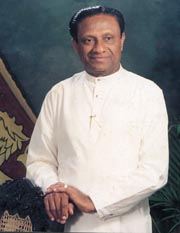<Back to Index>
- Physician and Social Activist Karol Marcinkowski, 1800
- Composer Stéphane Raoul Pugno, 1852
- 3rd President of Sri Lanka Ranasinghe Premadasa, 1924
PAGE SPONSOR

Ranasinghe Premadasa (Sinhala: රණසිංහ ප්රේමදාස Tamil: ரணசிங்க்ஹி பிரேமதாசா) (June 23, 1924 - May 1, 1993) was the 3rd President of Sri Lanka from January 2, 1989 to May 1, 1993. Before that, he served as the Prime Minister in the government headed by J.R. Jayewardene from February 6, 1978 to January 1, 1989. He was assassinated in Colombo in asuicide bombing, by the LTTE.
Ranasinghe Premadasa came from a family of modest means, as such his political rise was resented by some of his rivals from the two or three Govigama caste families who had inherited political power, during and post British colonial rule. He attended St Joseph's College, Colombo, which at that time had started an oriental languages course. Richard Ranasingha wished his son to follow this course. He originally planned to be a journalist, and translated an autobiography of Jawaharlal Nehru into Sinhala.
Premadasa was married to Hema Wickrematunge and had three children. Sajith and daughters Dulanjali and Ranjith, his son, is the MP for Hambantota District. Premadasa's entry into politics was made from the Labour Party, then headed by A.E. Goonesinha. Having realized that the Labour Party in the 1950s did not have a very promising future, Premadasa joined the moderate United National Party, and became the first non - Govigama politician to reach to the highest levels in democratic, post - independence Sri Lanka. During his tenure as Minister of Broadcasting in Dudley Senanayake's cabinet, Premadasa turned Radio Ceylon, the oldest radio station in South Asia, into a public corporation - the Ceylon Broadcasting Corporation on 5 January 1967. Part of his political program was shelter for the poor, after the United Nations declared a Year of Shelter. Other policies included Jana Saviya, the instrument he used to help the poor, a foster parents scheme, the Gam Udawa project
with which he tried to stir up the stupor in the villages, the mobile
secretariat whereby he took the central government bureaucracy to the
peasants, the Tower Hall Foundation for drama and music, and the
pension schemes he initiated for the elder artists. On the economic
front, the garment industry project that he initiated became a
forerunner in earning foreign exchange and provision of employment in
the villages. This was just one step in the direction of taking the
economy to the outstations. Premadasa met with less success in dealing with Sri Lanka's civil war. When he assumed office, he faced a rebellion in the south from the hardline Sinhala - nationalist, Marxist Janatha Vimukthi Peramuna (JVP). The security forces brutally put down the revolt and killed many of its leaders. In the north, the Liberation Tigers of Tamil Eelam were facing off against the Indian Peace Keeping Force.
The Indian presence on the island was unpopular, and Premadasa
requested India to leave. In order to force IPKF to leave the island,
he authorized a clandestine operation to supply arms to LTTE according
to the report published by the Sri Lankan Presidential commission to
inquire into the 1992 assassination of one of the most senior officers
in the Sri Lankan army, Lt Gen Denzil Kobbekaduwa. The
inquiry also found that Premadasa ordered clandestine supply of arms to
LTTE. In the end, LTTE massacred 774 policemen using the same weapons
he had given to LTTE (the policemen were asked to surrender to LTTE in
Batticaloa at Premadasa's request). After the IPKF left in 1990, the government's war with the LTTE resumed, and resulted in stalemate. Premadasa
is well known for the unostentatious life led by him in his simple
home, away from his luxurious official residence. He perhaps travelled
less than any other leading Sri Lankan politician. During his
presidency, he also expelled from the UNP his two formidable rivals Lalith Athulathmudali and Gamini Dissanayake, who then joined to form the Democratic United National Front (DUNF). He was found to be involved in the assassination of Lalith Athulathmudali by a presidential commission appointed by President Chandrika Bandaranaike Kumaratunga.
Ranasinghe Premadasa was killed on 1 May 1993, during a
May day rally, by an LTTE suicide bomber. Little more than a week before, Lalith Athulathmudali had also been assassinated.